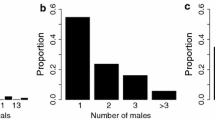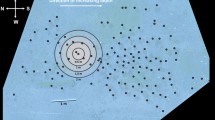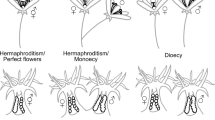Summary
Genotype frequencies of adult and juvenile Actinia tenebrosa from 2 populations showed that settlement and recruitment predominantly involved the localised asexual (ameiotic) proliferation of established genotypes. However, there is strong indirect evidence that the genotypic variation was generated by sexual reproduction. Genotypic structuring of these populations was detected at 2 levels. First, coarse clumping of genotypically identical adults and juveniles occurred on a scale consistent with the pattern of asexual dispersal. Second, fine-scale clustering of genotypically identical adults and juveniles occurred on a scale consistent with predicted effects of inter-genotypic aggression. Inter-genotypic aggression seems certain to play an important role in inter-genotypic competition for recruitment space and should reduce the input of genotypic variation into established populations. The applicability of the Strawberry-Coral Model to the life history of this species is discussed.
Similar content being viewed by others
References
Ayre DJ (1982) Inter-genotype Aggression in the solitary sea anemone Actinia tenebrosa. Mar Biol 68:199–205
Bell G (1982) The masterpiece of nature: the evolution and genetics of sexuality. London: Croon Helm
Bigger CH (1980) Interspecific and intraspecific acrorhagial aggressive behaviour among sea anemones: a recognition of self and not self. Biol Bull mar biol Lab. Woods Hole 159:117–134
Bigger CH, Runyan R (1979) An in situ demonstration of self recognition in Gorgonians. Devl Comp Immun (NY) 3:591–597
Black R, Johnson MS (1979) Asexual viviparity and population genetics of Actinia tenebrosa. Mar Biol 53:27–31
Bucklin A, Hedgecock D (1982) Biochemical genetic evidence for a third species of Metridium (Coelenterata: Actinaria). Mar Biol 66:1–7
Carter MA, Funnel M (1980) Reproduction and brooding in Actinia. In: Tardent P and Tardent R (eds) Developmental and Cellular Biology of Coelenterates. Elsevier/North-Holland Biomedical Press, pp 17–22
Carter MA, Thorpe CH (1979) The reproduction of Actinia equina L var mesembryanthemum. J Mar Biol Ass UK 59:989–1001
Chia FS (1976) Sea anemone reproductive patterns and adaptive radiations. In: Mackie GO (ed) Coelenterate ecology and Behaviour. Plenum Press, New York, pp 261–270
Francis L (1973a) Clone specific segregation in the sea anemone Anthopleura elegantissima. Biol Bull 144:64–72
Francis L (1973b) Intraspecific aggression and its effect on the distribution of Anthopleura elegantissima and some related sea anemones. Biol Bull mar biol Lab. Woods Hole 144:73–92
Hildemann WH, Jokiel PL, Bigger CH, Johnston IS (1980) Allogeneic polymorphism and alloimmune memory in the coral Montipora verucosa. Transplantation 30:297–301
Hoffmann RJ (1976) Genetics and asexual reproduction of the sea anemone Metridium senile. Biol Bull 151:478–488
Jokiel PL, Hildemann WH, Bigger CH (1982) Clonal population structure of two sympatric species of the reef coral Montipora. Bull Mar Sci (In press)
Levinton J (1973) Genetic variation in a gradient of environmental variability: marine bivalvia (Mollusca). Science, NY 180:75–76
Maynard Smith J (1978) The evolution of sex. Cambridge University Press, Cambridge
Orr J, Thorpe JP, Carter MA (1980) Biochemical genetic confirmation of the asexual reproduction of brooded offspring in the sea anemone Actinia equina. Mar Ecol-Prog Ser 7:227–229
Ottaway JR (1973) Some effects of temperature desiccation and light on the intertidal anemone Actinia tenebrosa Farquhar (Cnidaria: Anthozoa) Aust J mar Freshwat Res 24:103–126
Ottaway JR (1978) Population ecology of the intertidal anemone Actinia tenebrosa. I. Pedal locomotion and intraspecific aggression. Aust J mar Freshwat Res 29:787–802
Ottaway JR (1979a) Population ecology of the intertidal anemone Actinia tenebrosa. II. Geographical distribution, synonomy, reproductive cycle and fecundity. Aust J Zool 27:273–290
Ottaway JR (1979b) Population ecology of the intertidal anemone Actinia tenebrosa. III. Dynamics and environmental factors. Aust J mar Freshwat Res 30:41–62
Ottaway JR (1980) Population ecology of the intertidal anemone Actinia tenebrosa. IV. Growth rates and longevities. Aust J mar Freshwat Res 31:385–395
Purcell JE (1977) Aggressive function and induced development of catch tentacles in the sea anemone Metridium senile. Biol Bull nar biol Lab, Woods Hole 153:355–368
Purcell JE, Kitting CL (1982) Intraspecific aggression and population distributions of the sea anemone Metridium senile. Biol Bull nar biol Lab, Woods Hole 162:345–359
Rosen BR (1981) The tropical high diversity enigma — the corals' — eye view. In: Florey PL (ed) Chance, change and challenge. The evolving biosphere. British Museum and Cambridge University Press, pp 103–129
Sebens KP (1982) Asexual reproduction in Anthopleura elegantissima (Brandt) (Anthozoa: Actinaria): Seasonality and spatial extent of clones. Ecology 63:434–444
Shick JM, Hoffmann RJ (1980) Effects of trophic and physical environments on asexual reproduction and body size in the sea anemone Metridium senile. In: Tardent P and Tardent R (ed) Developmental and Cellular Biology of Coelenterates. Elsevier/North Holland Biomedical Press, pp 211–216
Shick JM, Hoffmann RJ, Lamb AN (1979) Asexual reproduction, population structure and genotype-environment interactions in sea anemones. Amer Zool 19:699–713
Theodor J (1970) Distinction between “self” and “not-self” in lower invertebrates. Nature 227:690–692
Underwood AJ (1980) The effects of grazing by gastropods and physical factors on the upper limits of distribution of intertidal macroalgae. Oecologia 46:201–213
Williams GC (1975) Sex and evolution. Princeton University Press, Princeton
Zar JH (1974) Brostatistical Analysis. Prentice-Hall, New Jersey
Author information
Authors and Affiliations
Rights and permissions
About this article
Cite this article
Ayre, D.J. The effects of asexual reproduction and inter-genotypic aggression on the genotypic structure of populations of the sea anemone Actinia tenebrosa . Oecologia 57, 158–165 (1983). https://doi.org/10.1007/BF00379575
Received:
Issue Date:
DOI: https://doi.org/10.1007/BF00379575




